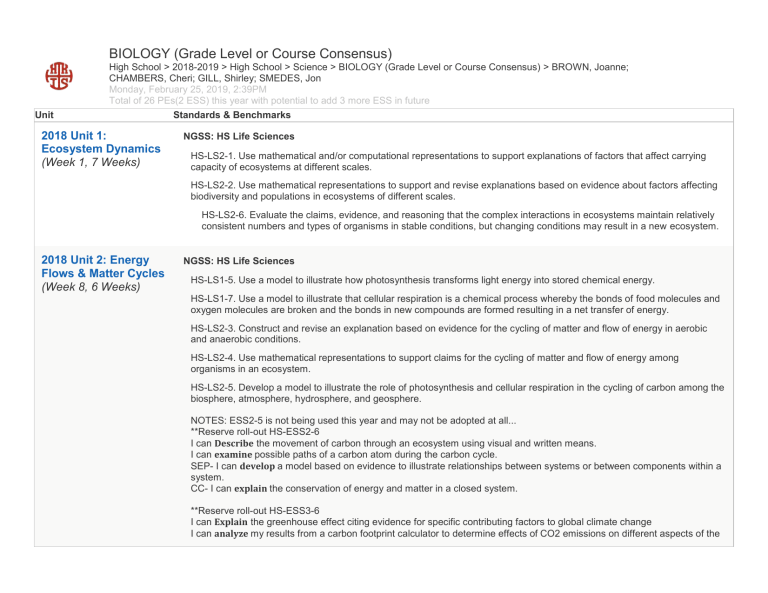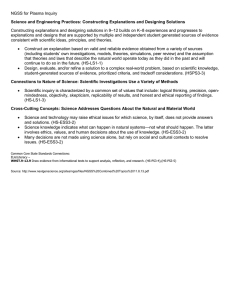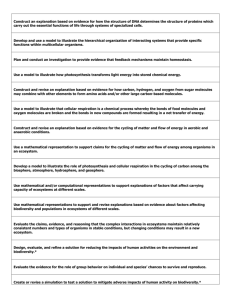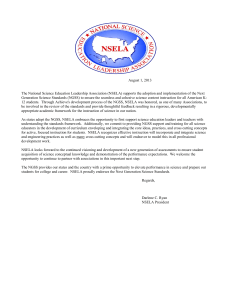
BIOLOGY (Grade Level or Course Consensus) High School > 2018-2019 > High School > Science > BIOLOGY (Grade Level or Course Consensus) > BROWN, Joanne; CHAMBERS, Cheri; GILL, Shirley; SMEDES, Jon Monday, February 25, 2019, 2:39PM Total of 26 PEs(2 ESS) this year with potential to add 3 more ESS in future Unit 2018 Unit 1: Ecosystem Dynamics (Week 1, 7 Weeks) Standards & Benchmarks NGSS: HS Life Sciences HS-LS2-1. Use mathematical and/or computational representations to support explanations of factors that affect carrying capacity of ecosystems at different scales. HS-LS2-2. Use mathematical representations to support and revise explanations based on evidence about factors affecting biodiversity and populations in ecosystems of different scales. HS-LS2-6. Evaluate the claims, evidence, and reasoning that the complex interactions in ecosystems maintain relatively consistent numbers and types of organisms in stable conditions, but changing conditions may result in a new ecosystem. 2018 Unit 2: Energy Flows & Matter Cycles (Week 8, 6 Weeks) NGSS: HS Life Sciences HS-LS1-5. Use a model to illustrate how photosynthesis transforms light energy into stored chemical energy. HS-LS1-7. Use a model to illustrate that cellular respiration is a chemical process whereby the bonds of food molecules and oxygen molecules are broken and the bonds in new compounds are formed resulting in a net transfer of energy. HS-LS2-3. Construct and revise an explanation based on evidence for the cycling of matter and flow of energy in aerobic and anaerobic conditions. HS-LS2-4. Use mathematical representations to support claims for the cycling of matter and flow of energy among organisms in an ecosystem. HS-LS2-5. Develop a model to illustrate the role of photosynthesis and cellular respiration in the cycling of carbon among the biosphere, atmosphere, hydrosphere, and geosphere. NOTES: ESS2-5 is not being used this year and may not be adopted at all... **Reserve roll-out HS-ESS2-6 I can Describe the movement of carbon through an ecosystem using visual and written means. I can examine possible paths of a carbon atom during the carbon cycle. SEP- I can develop a model based on evidence to illustrate relationships between systems or between components within a system. CC- I can explain the conservation of energy and matter in a closed system. **Reserve roll-out HS-ESS3-6 I can Explain the greenhouse effect citing evidence for specific contributing factors to global climate change I can analyze my results from a carbon footprint calculator to determine effects of CO2 emissions on different aspects of the Unit Standards & Benchmarks planet. SEP-I can utilize a computational representation of phenomena to support claims and explanations. CC-I can analyze the boundaries and initial conditions of a system, including inputs and outputs, using models. 2018 Unit 3: Biochemistry & Homeostasis (Week 14, 6 Weeks) NGSS: HS Life Sciences HS-LS1-2. Develop and use a model to illustrate the hierarchical organization of interacting systems that provide specific functions within multicellular organisms. HS-LS1-3. Plan and conduct an investigation to provide evidence that feedback mechanisms maintain homeostasis. HS-LS1-6. Construct and revise an explanation based on evidence for how carbon, hydrogen, and oxygen from sugar molecules may combine with other elements to form amino acids and/or other large carbon-based molecules. 2018 Unit 4: Central Dogma & Heredity (Week 20, 8 Weeks) NGSS: HS Life Sciences HS-LS1-1. Construct an explanation based on evidence for how the structure of DNA determines the structure of proteins which carry out the essential functions of life through systems of specialized cells. HS-LS1-4. Use a model to illustrate the role of cellular division (mitosis) and differentiation in producing and maintaining complex organisms. HS-LS3-1. Ask questions to clarify relationships about the role of DNA and chromosomes in coding the instructions for characteristic traits passed from parents to offspring. HS-LS3-2. Make and defend a claim based on evidence that inheritable genetic variations may result from: (1) new genetic combinations through meiosis, (2) viable errors occurring during replication, and/or (3) mutations caused by environmental factors. HS-LS3-3. Apply concepts of statistics and probability to explain the variation and distribution of expressed traits in a population. NOTES: **3-1 is more about inheritance and mutations should be in evolution unit 1-4 goes better with specialization (1-1) 2018 Unit 5: Evolution (Week 28, 6 Weeks) NGSS: HS Life Sciences Performance Expectations Unit Standards & Benchmarks HS-LS2-8. Evaluate the evidence for the role of group behavior on individual and species’ chances to survive and reproduce. HS-LS4-1. Communicate scientific information that common ancestry and biological evolution are supported by multiple lines of empirical evidence. HS-LS4-2. Construct an explanation based on evidence that the process of evolution primarily results from four factors: (1) the potential for a species to increase in number, (2) the heritable genetic variation of individuals in a species due to mutation and sexual reproduction, (3) competition for limited resources, and (4) the proliferation of those organisms that are better able to survive and reproduce in the environment. HS-LS4-3. Apply concepts of statistics and probability to support explanations that organisms with an advantageous heritable trait tend to increase in proportion to organisms lacking this trait. HS-LS4-4. Construct an explanation based on evidence for how natural selection leads to adaptation of populations. HS-LS4-5. Evaluate the evidence supporting claims that changes in environmental conditions may result in: (1) increases in the number of individuals of some species, (2) the emergence of new species over time, and (3) the extinction of other species. NOTES: can we include plant info.-angiosperms, gymnosperms, evolution of sexual reproduction... 2018 Unit 6: Sustainable Solution (Week 34, 5 Weeks) NGSS: HS Life Sciences HS-LS2-7. Design, evaluate, and refine a solution for reducing the impacts of human activities on the environment and biodiversity.* HS-LS4-6. Create or revise a simulation to test a solution to mitigate adverse impacts of human activity on biodiversity.* NGSS: HS Earth & Space Science HS.Weather and Climate Performance Expectations HS-ESS3-5. Analyze geoscience data and the results from global climate models to make an evidence-based forecast of the current rate of global or regional climate change and associated future impacts to Earth systems. HS.Human Sustainability Performance Expectations HS-ESS3-4. Evaluate or refine a technological solution that reduces impacts of human activities on natural systems.* Atlas Version 9.3.6 © Faria Education Group 2019. All rights reserved. Privacy Policy






